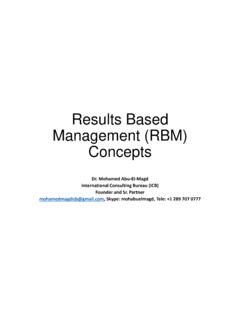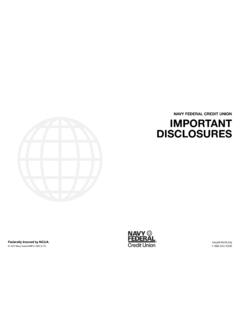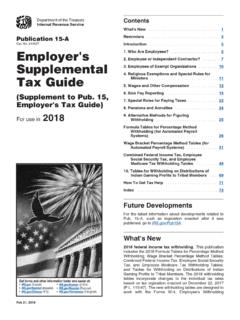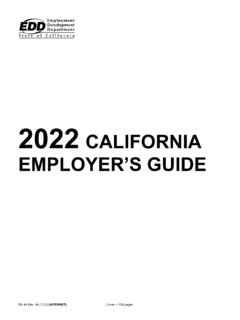Transcription of A Guide for Developing a Logical Framework - Orange
1 Centre for International Development and Training A Guide for Developing a Logical Framework Centre for International Development and Training University of Wolverhampton Gorway Road Walsall WS1 3BD. UK. Tel: +44 (0)1902 323219. Fax: +44 (0)1902 323212. E-mail: Web Site: 1. A Guide for Developing a Logical Framework1. Introduction The Logical Framework is a tool to help strengthen project design, implementation and evaluation. This means that you use it throughout the project cycle. The Logical Framework is a simple tool which helps you: * organise your thinking;. * relate activities and investment to expected results;. * set performance indicators;. * allocate responsibilities;. * communicate information on the project concisely and unambiguously.
2 Advantages of the Logical Framework approach The major advantages of the Logical Framework approach are: * It brings together in one place a statement of all key components of the project or programme. Having all key components of projects or programme in a systematic, concise and coherent way helps you clarify and demonstrate the logic of how projects and programmes are expected to work. It can also help you separate the various levels in the hierarchy of objectives, and consequently ensure that inputs and outputs are not confused with each other or with objectives. This can be particularly helpful when there is a change of staff. * It meets the requirements of good project design and enables possible responses to past weaknesses in many designs.
3 It can help ensure that fundamental questions are asked and weaknesses are analysed in order to provide decision makers with better and more relevant information. It can also Guide you in systematically and logically analysing the inter-related key elements which constitute a well designed project. This approach can help you improve planning by highlighting linkages between project elements and important external factors. * It is easy to learn and use. Effective training in the basics of the Logical Framework approach can be given in a few days. If this is combined with follow-up training and process consultancy to sort out difficulties a key group of project staff can be trained effectively in a short period of time. 1. Adapted from Mel Blunt's (Organisation Development Associates) adaption of the PC TeamUp User's Manual 2.
4 * It does not add time or effort to project management, but reduces it. Like many other management tools the Logical Framework approach has to be learnt before it can be effectively used. Once learnt however, it can save you a lot of time. Many project staff report that they are often short of time and work against the clock on a regular basis. Any time saved in relation to project management work would be of great value. * It can be used internally for design and appraisal process and can be used externally with consultants working for development organisations. The Logical Framework approach can be used to help both design and appraise projects internally. Likewise it can be used with external consultants who may be involved with design and appraisal processes.
5 In addition the Logical Framework approach encourages a multi- disciplinary approach to project design and supervision. * It anticipates implementation. The Logical Framework approach helps sets up project activities with a clear purpose. The approach facilitates common understanding and better communication between decision makers, managers and other parties involved in projects. Likewise the use of Logical Frameworks, with systematic monitoring, ensures continuity of approach if and when any original project staff move or are replaced. * It sets up a Framework for monitoring and evaluation where planned and actual results can be compared. By having objectives and indicators of success clearly stated before the project starts the approach helps you set up a Framework for evaluation.
6 It is notoriously difficult to evaluate projects retrospectively if the original objectives are not clearly stated. The Logical Framework approach can help clarify the relationships which underlie judgements about the likely efficiency and effectiveness of projects, likewise it can help identify the main factors related to the success of the project. * It assists communications between project donors and implementors. As more and more institutions adopt the Logical Framework concept communications between project implementors and donors will be facilitated. This will have major advantages for organisations who are continually presenting projects to donors for funding. In earlier times, budgets seemingly grew more easily and rapidly than now is often the case.
7 3. Limitations to the Logical Framework approach These are that: * It is not a substitute for other technical, economic, social and environmental analyses. It cannot replace the use of professionally qualified and experienced staff. The Logical Framework approach can help project design, implementation and evaluation, but clearly does not do away with the need for other project tools especially those related to technical, economic, social and environmental analyses. Likewise the approach does not replace the need for professional expertise and experience. * Rigidity in project management may arise when objectives and external factors specified during design are over emphasised. Rigidity in project administration and management can sometimes arise when Logical Framework objectives and external factors specified during design are over emphasised.
8 Note that this can, however, be avoided by regular project reviews where the key elements can be re-evaluated and adjusted. If the Logical Framework approach is taken up it is recommended that regular project reviews are undertaken and Logical Framework project documents kept up to date. * It requires a team process with good leadership and facilitation skills to be most effective. To prepare a good Logical Framework , where different professional perspectives are taken into consideration, a team approach is required. In order to get the team functioning there is a need for both leadership and facilitation skills. Many organisations that have adopted the Logical Framework approach have used external consultants to train their staff in the Logical Framework approach, facilitate their Logical Framework workshops and assist with the preparation of finalised Logical Frameworks.
9 In the development of these Logical Frameworks the objectives, objectively verifiable indicators, means of verification and assumptions/risks are agreed by all participants. * The process requires strong facilitation skills to ensure real participation by appropriate stakeholders. To prepare a good Logical Framework with the active participation of appropriate stakeholders is not easy. Participation requires the active involvement of stakeholders in the decision making process. Such participation will lead to greater effectiveness, ownership, efficiency, transparency, equity and sustainability. Facilitating, for example illiterate primary stakeholders effectively through the process requires great skill. * The whole culture of the Logical Framework can be alien.
10 The jargon can be intimidating even for those familiar with its culture'. In some cultures the Logical Framework can be very alien. 4. 5. You present your Logical Framework as a table with the following layout: S I V A. u n e s m d r s m i i u a c f m r a i p y t c t o a i r t o s i n o s n Goal Purpose Outputs Activities Step 1: Define the Overall Goal to which your project contributes The Goal is the higher-order objective that you S I V A are seeking to achieve through this project, G often in combination with others. It usually P relates to a programme or a sector. As an O example you may have a programme Goal of A. increasing farm family income. This may be partially achieved through a project with the Purpose of increasing farm production.






